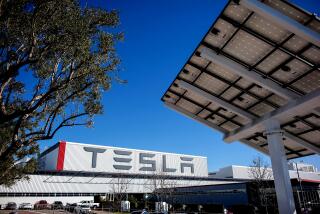Illuminating Lesson About Skilled Labor
- Share via
James Carley, president of Carley Lamps Inc., a Torrance-based maker of specialized lightbulbs, first went to Hong Kong in 1970 to set up an operation for Oak Industries, a maker of components for television sets.
Workers in Hong Kong were then making 19 cents an hour, Carley recalls. Today, they earn $8.50 an hour, including health and retirement benefits. How those wages grew and what that promises for the future of all developing regions, including China, Mexico and low-wage communities in Southern California, is part of the story of global business reflected in a small company.
Decades ago, Hong Kong caught a ricochet from Japanese competition in California. “In 1970, Japanese makers of TV components came in and cut prices drastically,” Carley said. Oak was then employing 300 people in Torrance. But its costs were no longer competitive, so Carley went to Hong Kong to set up a low-cost operation.
Oak later moved overseas manufacturing to Taiwan, and Carley--an engineer who went to work when he was 14 in 1943 for Chicago Miniature Lamp Works at wages of about 41 cents an hour--quit to set up his own company with a manufacturing base in Hong Kong.
Carley’s Hong Kong operation now turns out 1.2 million tiny lightbulbs a week for Mag Instrument Co., the Ontario-based maker of Mini-Maglite flashlights. “Hong Kong workers bring great productivity to repetitive jobs, of which the lamp business has many,” Carley remarks.
But even productive people get bored. As service jobs have opened up in finance and tourism, and as Hong Kong’s living standards have risen, Hong Kong labor has become more selective. A decade ago, Carley needed to produce new kinds of bulbs with aluminum reflectors for coal miners’ caps, but the Hong Kong work force was reluctant. “They were going through the motions, so I moved the product out of there,” Carley says.
He opened up production in Mexicali, where Carley Lamps now employs 440 people, compared with 200 in Hong Kong. The Mexicali operation produces a great variety of specialized-lightbulb orders for NASA space vehicles; ear, nose and throat medical devices; the nation’s coal miners; and police and fire department customers.
Meanwhile, the manufacturing industry is shrinking in Hong Kong, as work moves to mainland China. Hong Kong, which is building a $20-billion international airport, sees its future as a base for services and investment in China’s development.
*
Wilfred Wong, president of China Investment Group Ltd.--which represents the Singapore Government Investment fund, Hong Kong mega-billionaire Lee Shau Kee and U.S. mutual fund investors--explains his company’s approach: “We invest in infrastructure but not in construction, which is too risky.”
Instead, backed by $3.5 billion in investable funds, Wong’s group buys existing toll roads, handing the Chinese city or province the capital to construct a new road while China Investment collects the tolls on the old road or bridge.
Then, using cash flow from the tolls, Wong develops retail distribution networks in China. “We have two department stores now, in Wuhan and Guangzhou, and hope to have six more in the next few years,” says Wong, who studied business management at Oxford and Harvard as well as atHong Kong University.
The company is also introducing bottled water to China, supplying the luxury of clean water and anticipating a growing consumer economy as Chinese workers move into jobs in retail and other services.
To a Chinese government--and a world--worried about mass unemployment as China’s old industry is restructured, Wong’s investment strategy offers a reassuring glimpse of future development.
True enough, but what reassurance is there for Southern California in the Carley Lamps story? It’s notable that workers in Hong Kong are making $8.50 an hour including benefits, a wage that would attract many workers in this area. Yet Carley didn’t bring work home. He sent it to Mexico, which works at half the costs of Hong Kong.
“Workers here don’t want to do the continuous, repetitive work of stringing filament into lightbulbs that the Hong Kong women do,” Carley says. “Mexican workers don’t like the repetitive work, either, so we don’t move it from Hong Kong.”
Carley Lamps, which has grown to $15 million in sales, employs 40 people at its Torrance headquarters. The employees work largely in new product development, quality testing, design of tooling and marketing.
The jobs are good ones, paying $11 to $12 per hour, plus benefits and a profit-sharing program, because the functions are critical. Carley holds on to contracts for coal-miner caps because the bulbs are tested for 600 hours’ endurance although 400 hours is required.
New product development is essential because changing technology tends to make bulbs obsolete--”aircraft panel displays used to be big for us, but liquid crystal and electronic displays have shrunk the market,” says Carley.
So the company seeks niches, developing lights for NASA spacecraft and astronauts’ headgear, for example. Such sophisticated work earns more pay and profit than the old mass production.
But the message of Carley’s global success is a sobering one for Southern California: The more-skilled jobs have a future, but low-skilled production jobs, which started to vanish three decades ago, are not coming back.
Therefore, this region should redouble efforts in education to train people for the better jobs.
*
Hong Kong, which faces a similar transition to service jobs, holds lessons here. The territory has a first-rate education system. Also, realizing that its future lies with international markets, Hong Kong is building an international airport on time and under budget, and its everyday transit system is a model of efficiency and economic operation.
Southern California, by contrast, argues about the feasibility of expanding airports and squanders billions in muddle and failure in transportation.
More to Read
Inside the business of entertainment
The Wide Shot brings you news, analysis and insights on everything from streaming wars to production — and what it all means for the future.
You may occasionally receive promotional content from the Los Angeles Times.










